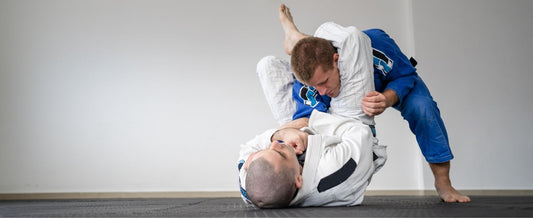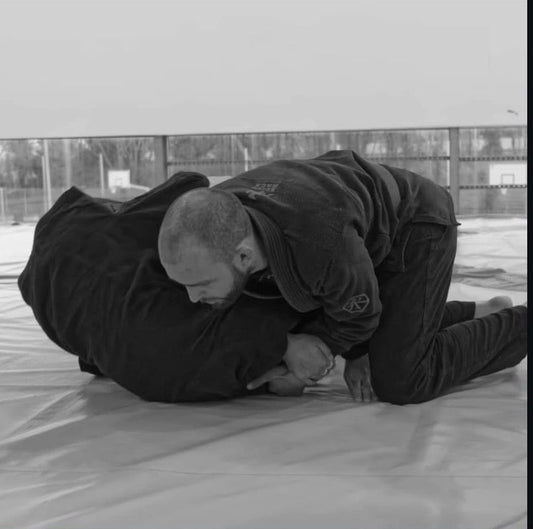Index:
1. Should you cut weight before a competition?
1.1 ✅ Reasons to consider weight loss
1.2 ❌ Reasons to avoid it
2. Risks of cutting weight incorrectly
3. Strategy to cut weight safely
3.1. Phase 1: Structured preparation (4-6 weeks before)
3.2. Phase 2: Technical cut-off (7-10 days before weighing)
3.3. Phase 3: Last 24-48 hours
4. Recovery after weigh-in
5. Common mistakes when cutting weight and how to avoid them
6. Alternatives to extreme weight cutting
These blogs might also interest you:
- Injuries in bjj, grappling, MMA, how to overcome them?
- When to change your BJJ kimono?
- Are knee braces necessary for jiujitsu?
Cutting weight is a fundamental part of the preparation of many BJJ, Grappling, and MMA athletes, but it's also one of the most mismanaged and risky processes if not done correctly. Is it really necessary for you? How does it affect your performance? What are the common risks and mistakes? In this article, we explain everything you need to know to decide if it's worth cutting weight before competing and, if so, how to do it safely and effectively without sacrificing your performance.
If you've experienced a lack of energy, weakness, extreme dehydration, or difficulty concentrating during a competition , you may not have cut weight correctly. And if it's your first time, this article will help you avoid fatal mistakes .
We'll discuss whether you should cut weight, the risks involved, the best strategies, and how to regain your strength after the weigh-in.
1. Should you cut weight before a competition?
The first thing you should ask yourself is whether you really need to cut weight. Not all athletes do this, nor do they need to.
✅ Reasons why you might consider cutting weight
1. You want to enter a lower category to face smaller rivals
This can be a strategic advantage if done right. In theory, by cutting weight, you can compete against people with less muscle mass or relative strength, which can give you an extra edge if your performance isn't compromised.
But beware : cutting weight doesn't automatically make you stronger. If you arrive weak, dehydrated, or lacking energy, the cut can backfire.
2. Your natural weight is slightly above the category in which you want to compete
If, for example, you weigh 72 kg and the weight class is up to 70 kg, you could make a small cut (2-3 kg) through diet, sodium reduction, or fluid management in the days leading up to the event. This is much more manageable and low-risk if you know what you're doing.
These small cuts are easier to recover well, especially if the weigh-in is the day before.
3. You have experience cutting weight and know how to recover
If you've cut before, you know how your body responds and how to manage rehydration, post-weigh-in nutrition, and rest. That's a game-changer.
This requires planning and prior practice. Don't improvise a cut if you don't know how you'll regain your strength to be at your best for the competition.
❌ Reasons why you should NOT cut weight
1. It's your first competition
When you're training, your main goal should be to learn, gain experience, and stay strong and focused . Adding the stress of cutting weight can distract you, make you weak, and ruin your experience.
Focus on performing well, not on weighing less . Competing at your natural weight is the best way to debut.
2. You have to cut more than 6-8% of your body weight in a few days
This is a red flag. Cutting more than 6-8% of your weight in less than a week can:
-
Become dangerously dehydrated.
-
Reduce your stamina and reflexes.
-
Cause cramps, dizziness, or extreme fatigue.
-
Increase your risk of injury.
If you're in this situation, it's best to rethink your category or your strategy . No title is worth your health.
3. You don't have a post-weigh-in recovery plan
Cutting weight is only one part of the process. The other, equally or more important, is how you rehydrate, replenish electrolytes, and refuel your muscles before the fight.
If you don't know what to eat, how much fluid to drink, or how long you need to recover... you can end up on the mat feeling like a zombie.
A bad refeed ruins all the effort of the cut .

Kimono Tenace
2. The risks of cutting weight incorrectly
Cutting weight isn't simply about not eating or sweating excessively before the weigh-in. It's a tool that, if misused, can backfire. Many people think that simply losing weight will improve their performance, but the reality is different: if you do it wrong, you'll arrive at the fight exhausted, weak, and even at greater risk of injury.
Let's go one by one:
🔹 Extreme dehydration
The most common and dangerous mistake. When you aggressively cut fluids, your body loses electrolytes, plasma volume, and intracellular water , which directly affects your neuromuscular performance. Losing focus can cost you a submission or a decisive blow.
What do you feel?
– Dizziness as soon as you move.
– Cramps in the middle of the roll.
– Your reaction is slower.
– You have a hard time thinking tactically.
🔹 Loss of muscle mass
When the calorie deficit is very aggressive and you don't do it with a structured strategy (combining training, macronutrient timing, and rest), the first thing that starts to break down isn't fat... it's muscle.
And here's the problem:
❌ You lose strength.
❌ You lose explosiveness.
❌ You feel slow on the tackles, weak on the scrambles, and lacking drive on the takedowns.
🔹 Inefficient recovery after weighing
Once you've lost weight, the second—and often more complicated—part is recovering well . It's not just "eat pasta and drink water." There's a science behind how and when to rehydrate, what foods to eat, in what order, and how long it takes to restore your optimal levels.
If you fail here, you may experience:
– That you feel heavy and slow.
– That you collapse in the middle of the first fight.
– You may experience nausea, heartburn, or dizziness just from moving.
🔹 Mental stress and anxiety
Cutting weight without a plan creates a tremendous psychological pressure . You're obsessed with the scale, how much you sweat, whether you can eat or not, and that leaves you without focus on what's most important: the fight.
You train irritated, you sleep poorly, and you arrive at the competition emotionally exhausted .
And if you're already anxious, the cut can increase it. It's not uncommon for inexperienced fighters to suffer panic attacks or abandon the cut at the last minute. The body feels it, but so does the mind.
According to research in combat sports, a poor weight cut can decrease your performance by 20 to 30% . This means you could end up fighting at only 70% of your true capacity , even if you've trained like a beast for eight weeks.
3. Strategy to cut weight safely
If you've already decided to cut weight for your next competition, the first thing you need to understand is that this isn't something you just can't do on a whim . A well-done cut can make the difference between competing at 100%... or arriving exhausted before you even step on the mat.
The key is to plan ahead, know your body, and respect each phase of the process.
📅 Phase 1: Structured preparation (4-6 weeks before the tournament)
This is the most important moment, where smart workouts replace dangerous shortcuts. Here, your main goal is to lose body fat , not water. Don't obsess over the daily scale just yet; focus on:
✅ Moderate and progressive caloric deficit
Design a diet that reduces your daily intake by 300 to 500 calories, adjusting it to your energy expenditure. This way, you'll lose fat while maintaining muscle mass and performance.
✅ High nutritional density
Eat clean: vegetables, fruits, lean proteins, good fats, complex carbohydrates. Zero ultra-processed foods. Every meal should add nutrients, not just calories.
✅ Smart water charging
Start drinking more water (4-6 liters daily) to train your body to eliminate fluids efficiently. This will be key when the water manipulation phase arrives.
✅ Sodium control
Start gradually reducing your salt intake. Less sodium means less fluid retention and less "false" weight on your body.
✅ Constant monitoring
Weigh yourself on an empty stomach every morning, measure your body fat if possible, and track your training performance. If you're losing weight but feeling sluggish, you're doing something wrong.
📅 Phase 2: Technical cut-off (7-10 days before weigh-in)
Here begins the strategic manipulation of the elements that influence your momentary weight: water, glycogen and intestinal waste .
✅ Carbohydrate reduction
Carbohydrates are stored as glycogen, and each gram of glycogen retains between 2 and 3 g of water. By reducing your intake, you safely reduce this retention. But be careful: don't eliminate them all. Keep some vegetables, rice, or potatoes to avoid losing energy.
✅ Progressive water cut
After a heavy water intake for several days, you begin to gradually reduce your intake (from 5L → 4L → 2L → 1L...). Your body continues to eliminate fluid as if you were drinking more, and so you lose weight in a controlled manner. It's hormonal manipulation, not magic.
✅ Minimal fiber, easy-to-digest meals
This helps reduce intestinal volume. Avoid raw vegetables and legumes. Prioritize cooked, soft foods that don't bloat the abdomen.
✅ No to extreme dehydration
Don't cut out all water suddenly or use laxatives or diuretics unsupervised. The goal is to temporarily and safely reduce body water, not to put your nervous system at risk.
📅 Phase 3: Last 24-48 hours before weighing
This is the final stretch. It's no longer about losing fat, but about minimizing your weight on the scale without compromising your integrity or performance.
✅ SAFE and controlled water loss techniques
Warm baths with Epsom salt, gentle sauna sessions (never more than 15-20 minutes continuously), and use of sweat suits or wetsuits if you're experienced. Always stay with someone, always hydrate strategically.
✅ Minimal and functional meals
Low volume, nothing bloating. Light proteins (boiled chicken, white fish), some healthy fat, and low-carb electrolyte fluids.
✅ Zero hard training
By now you've done all the work. No sparring, intense drills, or heavy lifting. Just light activation, stretching, breathing, and mental rest.

KNEE BRACE TENACE
Post -weighing recovery
Once you've gained weight, your priority is to regain energy, fluids, and electrolytes without damaging your digestion . It's not about eating like crazy or chugging liters of water all at once.
Do it in stages:
First rehydrate with electrolytes and water with salt and glucose.Then add liquid food (shake with simple carbohydrates and protein).Then, complete meals with carbs, protein and some fat.
Strategy Summary:
🔄 Planning from 4-6 weeks in advance.🥗 Clean, balanced, and deficit-controlled diet.
💧 Progressive water manipulation, no fuss.
🛁 Safe and well-calculated water loss techniques.
🍽️ Smart post-weigh-in recovery.
4. Recovery after weigh-in
This is, without a doubt, the most overlooked step by many fighters… and one of the most crucial. A poor recovery plan can make all the effort from the cut go down the drain . Ideally, you should arrive at the fight feeling strong, fast, and energetic, not bloated, sluggish, or nauseous.
When is the weigh-in? This changes everything.
📌 If the weigh-in is on the same day as the fight:
Forget about extreme cuts. Your recovery time is minimal. The most important thing here is to stay close to your actual weight , make sure you're well hydrated, and arrive with energy. In these cases, a slight deficit for the weeks leading up to your workout works better than an aggressive cut.
📌 If the weigh-in is the day before:
You have between 12 and 30 hours to rehydrate, replenish glycogen, and feel back to your best. This is the ideal scenario for structured recovery.
💧 STEP 1: Gradual and intelligent rehydration
After weighing in, DO NOT drink a liter of water all at once . Your digestive system has been on hold, and this could cause vomiting, cramps, or even electrolyte imbalances.
✅ Start with small sips of an electrolyte-rich (sodium, potassium, magnesium) drink, such as a homemade mix with salt, lemon, and water.
✅ After 20-30 minutes, add mineral water or water with mild electrolytes. Aim to replace 100-150% of the lost fluid , but do so in installments over 4-6 hours.
🍚 STEP 2: Load up on easily digestible carbs
The priority is to replenish muscle glycogen , your main source of energy in combat. But just like with hydration, it should be done in phases.
✅ First meal (liquid or semi-solid):
A shake with simple carbohydrates (such as maltodextrin or dextrose), a little protein (whey), and some sodium. This goes straight to your muscles without overwhelming your stomach.
✅ Then, easy-to-digest solid foods:
-
Cooked white rice
-
Ripe banana
-
Toast
-
Cooked oats
-
Boiled potato
Combine them with lean proteins (chicken, eggs, white fish) and some healthy fats (avocado, olive oil). The goal is to eat small portions every 2-3 hours , not binge eating.
🚫 STEP 3: What to avoid before the fight
❌ Heavy or greasy meals
Avoid fried foods, sausages, hard cheeses, and heavy sauces. Fat slows digestion and can make you feel heavy or sluggish.
❌ Excess sugars without control
Although you need fast carbs, don't go overboard with chocolates, cakes, or sugary drinks. They can destabilize your energy.
❌ Excess fiber
Avoid raw vegetables, legumes, or whole grains. Although they're healthy, they can cause bloating or gas just before a competition.
A few hours after weighing and while you are eating, make gentle movements:
- Joint mobility
- Deep breathing
- Light shadows
- Walks
This reactivates the body without generating fatigue and helps you get into fight mode .
5. Common mistakes when cutting weight and how to avoid them
🔴 MISTAKE 1: Trying to lose too much weight in a few days
➡️ SOLUTION: Plan ahead and do it gradually.
🔴 MISTAKE 2: Not hydrating properly after weigh-in
➡️ SOLUTION: Rehydrate with water and electrolytes in small amounts.
🔴 MISTAKE 3: Stopping eating completely
➡️ SOLUTION: Reduce calories wisely, but still eat protein and healthy fats.
🔴 MISTAKE 4: Relying on diuretics or laxatives
➡️ SOLUTION: Use natural methods to eliminate fluids without affecting your health.
🔴 MISTAKE 5: Cutting weight without a recovery plan
➡️ SOLUTION: Have a clear strategy for replenishing fluids, carbohydrates, and electrolytes before the competition.
6. Alternatives to extreme weight cutting
Not everything in the game is about sweating buckets in a sauna or wrapping yourself in plastic the night before the weigh-in. In fact, the athletes who manage to maintain their performance consistently throughout the year are those who understand that extreme weight cutting isn't always the best option .
Let's look at some strategies that work just as well, or even better, without compromising your health or performance.
✅ 1. Compete at your natural weight
Many fighters underestimate how powerful this option can be.
If you stay well trained, eat well, and are not overweight for your weight class, competing at your natural weight can give you a huge advantage :
🔹 You arrive at the fight without stress, without dragging fatigue.
🔹 You can train hard until the day of the fight, without cutting back on intensity.
🔹 You focus on technique and tactics, not on surviving the weigh-in.
🎯 This is a great option if you're a beginner, in the learning stages, or just prefer to give 100% in the cage without worrying about regaining weight.
✅ 2. Improve your body composition
We're talking about a long-term approach here. It's not about losing weight in a week, but rather transforming your body over time to optimize muscle mass and reduce body fat .
🔹 If you lose fat and maintain (or even gain) muscle, you may end up weighing the same… but stronger, faster, and more explosive.
🔹 This allows you to downgrade without resorting to extreme techniques.
🔹 Plus, your body becomes more efficient, with improved performance and less risk of injury.
💡 This is achieved through strategic eating, well-planned strength training, and year-round discipline. It's not something you just whip up the week before your weigh-in.
✅ 3. Weight control all year round
This is the secret of elite athletes.
Staying close to your competition weight (no more than 3-5% difference) throughout the year allows you to fine-tune details before the tournament, without the need for last-minute “miracles.”
🔸 You can compete more often without going through the stress of cutting weight every time.
🔸 Your body doesn't go through hormonal peaks and valleys because it's constantly going up and down.
🔸 Stay ready for last-minute tournaments without sacrificing performance or health.
📌 How to achieve it?
-
With good daily habits: balanced diet, constant hydration, and smart training.
-
Avoiding the typical ups and downs of those who “gain 10 kilos on vacation and lose 10 at camp.”





